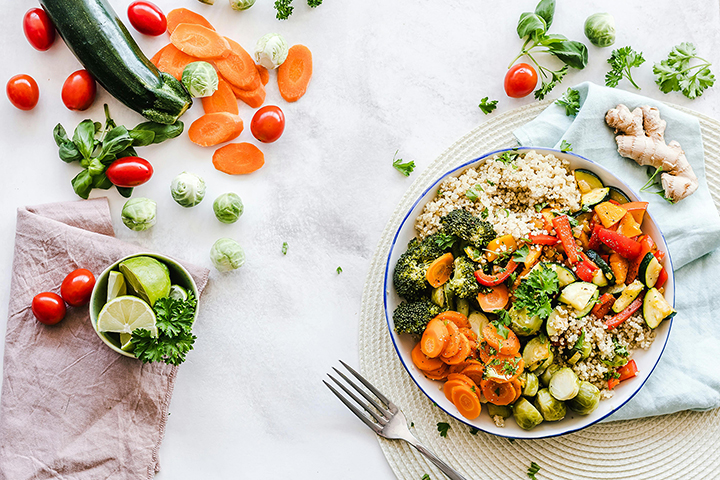Elimination Diet: The Why and How of Figuring Out Food Sensitivities
An elimination diet can help you identify otherwise undiagnosable food sensitivities.
Do you have nagging symptoms that your doctor can’t figure out, or they just give you medication to cover up the symptoms? Do you feel like something is off, but all your labs come back “normal”?
The problem could be hidden in your food, and an elimination diet can offer you the clarity you’re looking for.
As an acupuncturist, patients often come to me to seek natural relief from health issues that either can’t be treated by conventional medicine, or that doctors only know to cover up with pharmaceuticals.
But my goal is not just to provide another bandage that just covers up symptoms. Instead, I like to work together with my patients to figure out what’s causing those symptoms in the first place.
I’ve found that if we dig a little deeper, try some different strategies, and have a bit of patience, we can often uncover the root cause of the symptoms. And once the root cause is taken care of, the symptoms often resolve all on their own.
What you’ll learn in this article:
- The root cause of your symptoms
- What is an elimination diet?
- What’s the difference between a food allergy, food intolerance, and food sensitivity?
- Why is it important to identify food sensitivities?
- Signs you may have a food sensitivity
- Most common food sensitivities
- How to do an elimination diet
- What to eat on an elimination diet
- Things to be aware of before you do an elimination diet
- FAQ
- Next steps: What to do after your elimination diet
The Root Cause of Your Symptoms
Symptoms are your body’s way of telling you that it needs help.
Whether it’s just one symptom or a full-blown diagnosed disease, the issue is always an imbalance in the body.
The body is always striving for homeostasis. Homeostasis is the sweet spot where hormones are released when they’re supposed to be released, nutrients are easily extracted and transported to the places where they are needed most, and all physiological processes run without a hitch.

Of course, the reality is that there are an infinite number of factors influencing a biological system at every moment, so maintaining homeostasis is insanely complex.
If you have any sub-optimal symptoms showing up, it’s a sign that your body is having a hard time maintaining homeostasis.
How to find the root cause of your symptoms
There are an infinite number of possibilities as to why your body might be having a hard time maintaining homeostasis, but the vast majority of dis-ease originate from 4 places: Food, lifestyle, environment, chronic stress and trauma, or a combination.
Food
The food you eat doesn’t just provide the building blocks for your physical body, it also impacts your physiology. If you eat foods or ingredients that your body is sensitive to, or eat too much of certain foods and not enough of others, your body has more work to do and a harder time maintaining homeostasis.

Related: 9 Ways to Improve Gut Health
Lifestyle
Bodies thrive on predictability and movement, so in addition to diet you also want to consider factors like sleep and exercise when looking for a root cause.
Environment
Outside factors as obvious as chemical toxins or as subtle as the weather can also have an impact on your body’s ability to maintain homeostasis.
Chronic Stress and Trauma
Everything in your physiology changes when your sympathetic nervous system is active, which is why chronic stress and trauma are well-known to be at the root of most diseases.
The idea is not to eliminate stress entirely—you’d make yourself more stressed in that attempt because it’s impossible! Instead, you want to support your nervous system so you can process, change, and override the stress patterns that are stored in there. Over time, you this helps you have an easier time dealing with the inevitable slings and arrows life throws your way.
So how can you start healing the root of your symptoms?
It takes some digging, and one of the best ways to rule out any food-related issues is through an elimination diet.
What is an Elimination Diet?
An elimination diet is an experiment you conduct on yourself to find out if you have undetected food sensitivities.
What’s the difference between a food allergy, food intolerance, and food sensitivity?
They sound similar, but there are some important differences between food allergies, intolerances, and sensitivities.
Food Allergy
A food allergy involves an immune response with extreme and obvious allergic symptoms. These include upset stomach, hives, swelling, wheezing or trouble breathing, dizziness, and difficulty swallowing.
Symptoms usually appear within 30 minutes-2 hours and can be life-threatening if left untreated. (1)
Food allergies can be tested at an allergist’s office using a skin-prick test or blood test.
Food Intolerance
A food intolerance happens when your body has a hard time breaking down and digesting a certain food. A common example of a food intolerance is lactose intolerance, where the body doesn’t produce the right kind or amount of enzymes to digest milk.
Food intolerances most often lead to to gastrointestinal symptoms like diarrhea, gas, bloating, heartburn, nausea, and stomach pain.
Food Sensitivity
The words “food intolerance” and “food sensitivity” are often used interchangeably, but they are actually two different things.
Food sensitivities happen when the body reacts to specific foods with a low-grade inflammatory response. If you eat a food that you’re sensitive to often, you end up with chronic low-grade inflammation in your system, which can lead to a host of uncomfortable symptoms that sometimes look nothing like an allergic reaction.
Symptoms can take a few days to develop, so it can be challenging to pin-point which foods are to blame without a clear system like an elimination diet.
Food sensitivities often originate from gut-dysbiosis, so if you take measures to heal your gut, there’s a good chance you’ll be able to eat moderate amounts of foods that you’re sensitive to down the line. Of course, you have to heal your gut first, so it’s best to be cautious, especially in the beginning.
Because there are no reliable lab tests available, the best way to diagnose a food intolerance or sensitivity is through an elimination diet.
Why is it important to identify food sensitivities with an elimination diet?
Because food sensitivities don’t just cause uncomfortable symptoms, they can impact your overall health and create a cascade of bigger health issues down the line.
Signs you may have a food sensitivity
Some of the most common symptoms of food sensitivity include:
- Chronic sinusitis, stuffy or runny nose
- Headaches and migraines
- Gas, bloating
- Loose stools, constipation, or both
- Fatigue
- Insomnia
- Brain fog
- Anxiety, depression, problems with focus/attention
- Joint or muscle pain
- Itching
- Flushed skin
- Acne
- PMS
- Menopausal symptoms
- Frequent colds/illnesses

Most common food sensitivities to consider for an elimination diet:
This list is not exhaustive because every body is different, and you could potentially develop a sensitivity to any food, especially when eaten in excess.
But there are some foods that tend to cause inflammation in larger portions of the population.
The most common foods that cause sensitivities include:
- Dairy
- Eggs
- Gluten
- Corn
- Nightshades (like potatoes, tomatoes, eggplant, peppers)
- Soy
- Tree nuts (like cashews, walnuts, etc.)
- Shellfish
- Coffee/Caffeine
- Mushrooms
- Citrus fruit (lemons, limes, oranges, grapefruit)
- Other foods that contain histamines, like pineapples, bananas, strawberries, avocados, and chocolate
Foods that are well-known to cause inflammation (aka pro-inflammatory foods):
- Peanuts
- Alcohol
- Ultra-processed foods
- Sugar/sweeteners
If you have symptoms that can’t otherwise be explained, an elimination diet can help you figure out if one or more of these foods is causing issues for you.
Related: Could Ultra Processed Food be to Blame for the National Mental Health Crisis?
How to do an elimination diet
An elimination diet is an experiment you do on yourself, and its most effective when you eliminate as many factors as possible that could mess with your results.
During an elimination diet, you want to remove all suspected food groups from your diet for 4-8 weeks, and then systematically reintroduce each, one at a time, to record results.
The reason for this long elimination period is that you want to give your body a chance to heal and recover. Once the inflammation has gone down and your body is functioning better again, it’ll be really clear that a specific food is to blame if you eat it and symptoms show up again.
Step 1: Observe and form a hypothesis to guide your elimination diet
The first step is to observe your symptoms and see if you notice any flare-ups after eating certain foods. This first part of the process can take anywhere from 2-4 weeks, depending on how diligent you want to be.
It can be tricky, because symptoms from food sensitivities don’t always show up right away. Sometimes it can take 2-3 days for symptoms to appear, which is why you want to go on to do a full-blown elimination diet once you have your primary suspects.
But if you don’t want to eliminate every ingredient on the list above (hard but do-able,) then taking some time to observe your symptoms is going to help you whittle down the list.
Keep a food journal to gain clarity
A food journal can help you keep track of the foods you eat and your symptoms so you can recognize patterns more easily. This will help you determine which foods to prioritize in your elimination diet.

Things to include in a food journal:
- The food you eat, including as many ingredients as possible
- Whether your meal includes only real food or also ultra-processed foods
- Whether your food is organic or not
- Whether any meat products you consume are factory-farmed (the feed, hormones, and antibiotics given to the animals can all impact your health)
- Your bowel movements’ frequency, quality, and comfort
- Gas, bloating, abdominal cramps
- Headaches
- Nasal congestion
- Body aches
- Anxiety, depression
- Other symptoms
- Factors that may cause similar symptoms or enhance food sensitivities:
• Your stress level
• Where you are in your menstrual cycle, if applicable
• How much sleep you’ve gotten, the quality of your sleep, and how well-rested you feel
Work with a holistic practitioner to design the best elimination diet for you
A holistic practitioner can help you identify symptom patterns that might not be obvious to you, and this this can help you whittle down the list of foods that you need to eliminate.
For example, people who have a lot of heat symptoms tend to be more sensitive to nightshades, people who experience a lot of mucous tend to have issues with dairy, and people who experience frequent gas, bloating, and abdominal discomfort often have a sensitivity to too much gluten.
Schedule an appointment with Katerina to get more clarity about your personal collection of symptoms, and which foods are most likely to cause issues for you.
It’s important to remember that these are not hard and fast rules, just patterns that tend to show up. Your body might respond differently, which is why it’s so helpful to do an elimination diet to figure out exactly which foods are causing problems for you.
Step 2: Research and Prepare for your elimination diet
Once you’ve identified potential culprits, start researching recipes and make a plan to cut those foods out of your diet. Again, this can be tricky, because if you consume a lot of these foods regularly, and can be hard to tell which ones are causing trouble.
It might sound daunting, but your best line of action in this case is to eliminate all of the foods you commonly eat so you have a clean slate to work from.
Unfortunately, if you continue to eat a food that causes inflammation in you while you eliminate the others, your results will be less clear and you might not get the answers you’re looking for.

Step 3: Eliminate Suspect Foods
Eliminate all suspected foods for 4-8 weeks.
For accurate results, it’s imperative that you stick with the elimination diet for the duration of your commitment. The longer you eliminate suspected foods, the more your body will have a chance to heal and recover and the more accurate your results will be during the reintroduction phase.
If you can, you’ll be most successful if you plan your elimination diet when you don’t have a birthday, wedding, big trip, or looming deadline coming up.
If you “cheat” and aren’t able to eliminate the relevant foods 100%, your results won’t be as accurate and all of your hard work will have been for nothing.
So if you have a history of yo-yo dieting and binge eating, consult a healthcare professional before starting an elimination diet because it may not be the best course of action for you.
An elimination diet can feel overwhelming at first, but if you keep things simple it doesn’t have to be difficult. The hardest part is getting used to eating a simpler diet, ensuring that you’re getting the nutrients you need, and sticking it out at social events or during times of stress.
Step 4: Reintroduce systematically
Once you’ve completed the elimination phase, it’s time to start the reintroduction phase.
This is the most important step in an elimination diet because it gives you all the information you’ve been waiting for. So while it might be tempting to skip this step, it’s important to stick it out just a little bit longer until you have your results.
Day 1: Choose one food-group/ingredient that you’ve eliminated and eat it for 3 meals on the first day of your reintroduction phase.
So for example, if you’d like to start with nightshades you might have a hash browns for breakfast, tomato soup for lunch, and stuffed peppers for dinner.
Observe and record: Cut that food-group out again on days 2 and 3 and observe and record any symptoms that appear.
If there were no symptoms, you can continue eating that food in moderation (don’t go overboard, amount matters!)
If there were symptoms or you’re not sure, eliminate that food-group/ingredient again for the duration of the reintroduction phase.

Day 4: Reintroduce another food-group/ingredient, record your symptoms for the following two days.
Again, if there were symptoms or you’re not sure, eliminate that food-group/ingredient for the duration of the reintroduction phase.
Continue like this until you’ve reintroduced and recorded the results for all of the food-groups/ingredients you eliminated.
What to Eat on an Elimination Diet
An elimination diet is not a starvation or weight-loss diet, and it’s important to make sure you’re getting all of the nutrients you need while you’re conducting this experiment.
Some people like to follow a modified Whole30 diet, since there are so many resources available to help you complete your time successfully.
But despite the ethos of Paleolithic and ketogenic enthusiasts, most people actually do very well on diets that include whole grains and beans, and there’s no need to eliminate them while doing your experiment unless you suspect that you may have a sensitivity to those specific ingredients.
In fact, whole grains combined with beans create a complete protein, so if you’re vegetarian you want to make sure you include them in your elimination diet, especially if you’re cutting out soy products, nuts, eggs, and/or diary.
For most people, a diet of whole grains, beans, a variety of colorful vegetables in various preparations, fruit for snacking, seeds, herbs, spices, and olive oil, is enough to give your body all the macro and micro nutrients it needs in order to thrive.
Boredom can definitely be a factor when doing an elimination diet.
You have a couple of options to help you overcome this.
First, you can embrace this time as an opportunity to change your relationship with food.
Secondly, you can also keep meals a bit more interesting by adding in soups/stews, sauces, and playing with spice blends from a variety of different culinary traditions to add variety to your meals.
A little bit of planning can go a long way, so set aside some time before your elimination phase, and again over the weekends, to come up with good options for the days ahead.
Things to be aware of before you start an elimination diet
Elimination diets are unlike other diets in that you’re conducting an experiment on yourself to find out which foods—if any—are causing symptoms.
You only do an elimination diet for a limited period of time, but still, it’s a big commitment, so there are a few things you want to keep in mind before you get started.
Symptoms may get worse before they get better
This is called a “healing reaction,” and is common with many natural medicine modalities like acupuncture and elimination diets.
There are a few theories as to why healing reactions happen, but one of the most popular is that your body’s detoxification improves, so it’s like you’re bringing all the muck in a pond up to the surface before it can be cleared away.
You have to commit to the whole time or results will be invalid
As mentioned above, if you can’t commit to fully eliminating suspected foods for the duration of your elimination phase, results won’t be valid during the reintroduction phase and you will have wasted a lot of time and effort for nothing.
“Cheat days” aren’t a thing when it comes to elimination diets, because you’re not doing this to lose weight or attain any immediate health goals. You’re doing this to find out which foods are making you sick, and you can’t find that out if you don’t experiment systematically.
Amount matters
Sometimes, with food sensitivities, it’s not a matter of what you eat but how much of it you eat. This is often the issue with gluten and dairy. Most people do well with small amounts of these foods in their diets, but they overload their system by eating them too much.
So another thing to consider is whether your tolerance level for your suspected food-groups/ingredients is part of the issue. Once you know what causes symptoms for you, you can continue your experiment to figure out how much is too much, and make informed decisions from there.
Quality matters
In addition to specific ingredients and food groups, many people find that symptoms appear when they eat foods with preservatives and additives, so you may want to test for those, too.
To get the best results, only eat real foods from whole ingredients.
This means pretty much nothing that comes in a package, (though there are a few exceptions if you really look for them).
You also want to stick to organic foods if at all possible for the duration of your experiment, so you don’t expose yourself to pesticides and other chemicals that might also be contributing to your symptom profile.
Related: Could Ultra Processed Food be to Blame for the National Mental Health Crisis?
Context matters and bodies change
If you are sensitive to specific food groups or ingredients right now, your reintroduction phase will tell you, but this doesn’t mean you need to avoid those foods for the rest of your life.
Gut health, climate, stress levels, and other lifestyle factors can all impact how well your body can handle certain foods, and while an elimination diet can make you aware of your vulnerabilities, it can’t tell you how your body will respond for the rest of your life.
If you take care of yourself by getting enough sleep, the right kind of exercise, and learn to eat according to the season and your personal constitution, there’s a good chance you’ll be able to incorporate the foods that you’re sensitive to back into your diet down the line without too many problems.
The most important thing is that you have this information so you can make informed decisions moving forward, so if you have an important presentation coming up, for example, you can know what to avoid so you feel your best when you really need to.
Social Pressure
Elimination diets are very restrictive, and it can be challenging to deal with social pressures from family and friends who may not understand why you’re doing it and why an elimination diet doesn’t allow for as much flexibility as other diets.
They may accuse you of being “too strict” and try to encourage you to “loosen up” or “cheat”.
You might also find it difficult to cook separate meals for your family.
It’s best way to avoid succumbing to social pressure is to use the WOOP method and make a plan for what you will do if/when it becomes an issue. The more prepared you are, the easier it will be for you to follow-through.
Elimination Diet FAQ
Here are some of the most frequently asked questions about elimination diets.
Why eliminate so many foods at once? Can you just eliminate one at a time?
You could eliminate foods one at a time to make the process less overwhelming, but then you run the risk of unclear results.
This is because if you’re sensitive to more than one food-group/ingredient, your body will continue to have an inflammatory response even while one food is eliminated, so there won’t be any obvious changes in the reintroduction phase that would indicate a specific food is causing issues.
Will I lose weight on an elimination diet?
The goal of an elimination diet is not to lose weight, but instead to identify the food-groups and ingredients that are making you sick.
You should never go hungry or skip meals while on an elimination diet.
That said, some bodies do shed unneeded pounds when inflammation goes down, so weight loss is not unheard of when inflammatory foods are removed.
Will I have to eliminate those foods forever?
You don’t have to do anything you don’t want to! The whole point of the elimination diet is to give you the information you need to make informed choices about your food and health.
If you discover that you’re sensitive to gluten, dairy, and nightshades, but pizza is your favorite food, you may decide to only eat pizza on a Friday night when you know you’ll be able to spend the weekend recovering. Or you might decide to eat it every day, anyway.
There are no right or wrong answers here, just choices and their consequences.
Wait, aren’t most of the foods on that list healthy though?
There’s no such thing as a healthy food. There are foods that tend to benefit people’s health, but they’re not going to benefit everyone in the same way.
There’s no such thing as one-size-fits-all when it comes to health, so if you want to be healthy, you have to do a little bit of work to figure out what is healthy for you, given your unique constitution and circumstances.
Doing an elimination diet is a great place to start.
Next Steps: What to do after your elimination diet
Many people will get very clear results from an elimination diet. Others go through the whole thing and are disappointed because they don’t notice much of a difference. Either way, you have more clarity about the food you choose to put in your body after you complete an elimination diet.
Still, questions might linger, and some symptoms might not resolve entirely.
If this happens to you, it can be helpful to work with a licensed holistic health practitioner like Katerina to do a bit more digging into other possible contributing factors.
Regular acupuncture treatments can also help you reduce and manage your symptoms. Click here to learn more and book a session today.





